
Magdalenian cultures are later cultures of the Upper Paleolithic and Mesolithic in western Europe. They date from around 17,000 to 12,000 years ago. It is named after the type site of La Madeleine, a rock shelter located in the Vézère valley, commune of Tursac, in France's Dordogne department.

Papasidero is a village and comune in the province of Cosenza in the Calabria region, southern Italy. It is part of Pollino National Park.

Aadloun, Adloun or Adlun is a coastal town in South Lebanon, 17 kilometres (11 mi) south of Sidon famous for its cultivation of watermelons. It is also the site of a Phoenician necropolis and prehistoric caves where four archaeological sites have been discovered and dated to the Stone Age. The evidence of human occupation of Abri Zumoffen has been dated as far back as 71,000 BCE with occupation of Bezez Cave dating back even further into the earlier Middle Paleolithic.
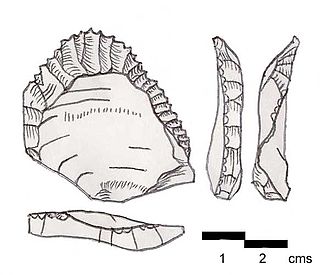
Ksar Akil is an archeological site 10 km (6.2 mi) northeast of Beirut in Lebanon. It is located about 800 m (2,600 ft) west of Antelias spring on the north bank of the northern tributary of the Wadi Antelias. It is a large rock shelter below a steep limestone cliff.

Kozarnika or Peshtera Kozarnika is a cave in northwestern Bulgaria that was used as a hunters’ shelter as early as the Lower Paleolithic. It marks an older route of early human migration from Africa to Europe via the Balkans, prior to the other currently suggested route - the one across Gibraltar. The cave probably keeps the earliest evidence of human symbolic behaviour and the earliest European Gravette flint assemblages came to light here.

The Vela Spila cave is situated above the town of Vela Luka on the island of Korčula, in Croatia on Pinski Rat hill at an elevation of approximately 130 m (430 ft). The cave consists of an elliptically shaped cavern that measures 40 m (130 ft) in length, 17 m (56 ft) in height, and is approximately 40 m (130 ft) wide. There are, similar to the Brillenhöhle in Germany, two openings in the roof of the cave which were caused by collapse at an as yet undetermined time.
Antelias Cave was a large cave located 2.5 km (1.6 mi) east of Antelias, 10 km (6.2 mi) northeast of Beirut close to the wadi of Ksar Akil.

The Hadži-Prodan's Cave is an archaeological site of the Paleolithic period and a national natural monument, located in the village Raščići around 7 km (4.3 mi) from Ivanjica in western central Serbia. The rather narrow and high entrance with at an altitude of 630 m (2,070 ft) above sea level sits about 40 m (130 ft) above the Rašćanska river valley bed and is oriented towards the south. The 345 m (1,132 ft) long cave was formed during the Late Cretaceous in "thick-bedded to massive" Senonian limestone. Prehistoric pottery shards and Pleistocene faunal fossils had already been collected by Zoran Vučićević from Ivanjica. Animal fossils especially Cave bear and Iron Age artifact discoveries during an unrelated areal survey were reportedly made at the cave entrance and in the main cavern. The site is named in honor of Hadži-Prodan, a 19th century Serbian revolutionary.
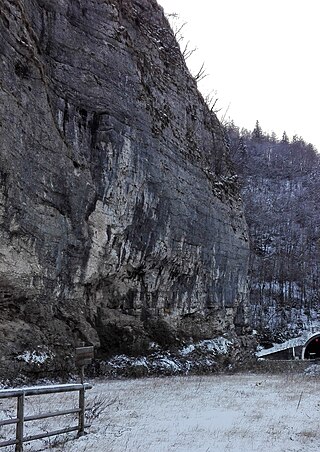
Ripari Villabruna is a small rock shelter in northern Italy with mesolithic burial remains. It contains several Cro-Magnon burials, with bodies and grave goods dated to 14,000 years BP. The site has added greatly to the understanding of the mesolithic development of medical and religious practises in early human communities.
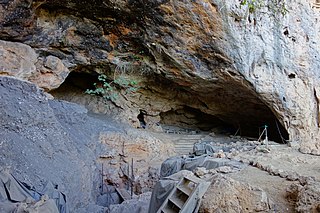
Taforalt, or Grotte des Pigeons, is a cave in the province of Berkane, Aït Iznasen region, Morocco, possibly the oldest cemetery in North Africa. It contained at least 34 Iberomaurusian adolescent and adult human skeletons, as well as younger ones, from the Upper Palaeolithic between 15,100 and 14,000 calendar years ago. There is archaeological evidence for Iberomaurusian occupation at the site between 23,200 and 12,600 calendar years ago, as well as evidence for Aterian occupation as old as 85,000 years.
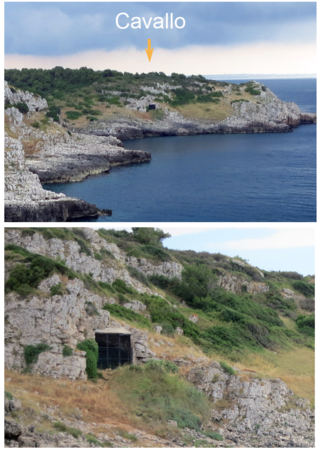
The Grotta del Cavallo or Cavallo Cave is a limestone cave in the region of Apulia, Southern Italy, near Nardò 90 km (55.92 mi) south of Taranto. The cave is about 15 m (49 ft) above present sea level. It has a rounded entrance, 5 m (16.40 ft) wide and 2.5 m (8.20 ft) high opening toward the sea. The cave was rediscovered in 1960 and two waves of excavations ensued. The first wave spanning from 1963 to 1966 and the second from 1986 to 2008. The cave was disturbed by looters during the period between the two waves of excavations, damaging the layers corresponding to the Upper Palaeolithic; because of this, the cave entrance is covered by a gate and is closed to the public.

Theopetra Cave is a limestone cave located in Theopetra village of Meteora municipality, Thessaly, Greece. It is situated on the northeast side of a limestone rock formation that is 3 km (2 mi) south of Kalambaka. The site has become increasingly important as human presence is attributed to all periods of the Middle and Upper Paleolithic, the Mesolithic, Neolithic and beyond, bridging the Pleistocene with the Holocene.

Trou de l’Abîme also known as La caverne de l'Abîme and Couvin Cave is a karst cave located in Wallonia on the right bank of the Eau Noire river in the center of Couvin, Belgium, in Namur province. During various archaeological excavations of sediment deposits, Mousterian artefacts and a Neanderthal molar were discovered.

The La Garma cave complex is a parietal art-bearing paleoanthropological cave system in Cantabria, Spain. It is located just north of the village of Omoño, part of the municipality of Ribamontán al Monte. The cave complex is noted for one of the best preserved floors from the Paleolithic containing more than 4,000 fossils and more than 500 graphical units. It is part of the Cave of Altamira and Paleolithic Cave Art of Northern Spain World Heritage Site.

The small Sirgenstein Cave, German: Sirgensteinhöhle is situated 565 m (1,854 ft) above sea level inside the 20 m (66 ft) high Sirgenstein, a limestone rock. The cave sits 35 m (115 ft) above the Ach River valley bottom in the central Swabian Jura, southern Germany. Archaeologist R. R. Schmidt excavated the site in 1906 during which he identified indices of prehistoric human presence. He recorded the complete stratigraphic sequence of Palaeolithic and Neolithic origin. In his 1910 analysis Schmidt inspired future archaeologists with his pioneering concept of including the excavation site within its geographic region, contextualizing it within a wide scientific spectrum and demonstrated valuable results as he correlated the Sirgenstein layer structure to those of prehistoric sites in France. Mammoth ivory beads dating from 39,000 to 35,000 years ago have been uncovered at the cave. Because of its historical and cultural significance and its testimony to the development of Paleolithic art, the cave was inscribed on the UNESCO World Heritage List as part of the Caves and Ice Age Art in the Swabian Jura site in 2017.

The Cave of Aurignac is an archaeological site in the commune of Aurignac, Haute-Garonne department in southwestern France. Sediment excavation and artefact documentation since 1860 confirm the idea of the arrival and permanent presence of European early modern humans during the Upper Palaeolithic. The eponymous location represents the type site of the Aurignacian, the earliest known culture attributed to modern humans in western Eurasia. Assemblages of Aurignacian tool making tradition can be found in the cultural sediments of numerous sites from around 45,000 years BP to around 26,000 years BP. In recognition of its significance for various scientific fields and the 19th-century pioneering work of Édouard Lartet the Cave of Aurignac was officially declared a national Historic Monument of France by order of May 26, 1921.
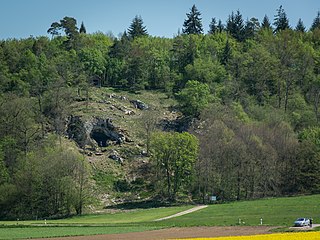
The Bockstein Cave, German: Bocksteinhöhle is part of the Bockstein complex – a White Jurassic limestone rock massif. The 15 by 20 m rock shelter, among small peripheral caves is situated around 12 m (39 ft) above the Lone River valley bottom, north of the towns of Rammingen and Öllingen, Heidenheim district in the central Swabian Jura, southern Germany. Several small openings, that are the actual entrances to the site, lead to various cave sections. The large frontal opening is of modern origin, created during the first excavation works in the late 19th century.

The Uluzzian Culture is a transitional archaeological culture between the Middle Paleolithic and the Upper Paleolithic, found in Italy and Greece.
Romuald’s Cave is a cave in the western part of Istria County, Croatia, that contains the oldest known cave paintings in southeast Europe, as well as traces of both animal and human Upper Paleolithic habitation. Although the cave has been excavated since late 19th century, the paintings were only found in 2010, by Professor Darko Komšo, while the findings were published in Antiquity in 2019.
Scaloria Cave, also known as Grotta Scaloria, is a cave in the province of Foggia, Apulia between the Tavoliere delle Puglie and the Gargano mountain massif with archaeological evidence of human behavior dating to the Upper Paleolithic. It is 2 km (1 mi) inland, 1 km northeast of Manfredonia.





















